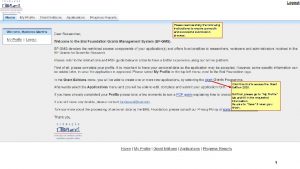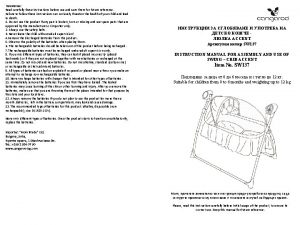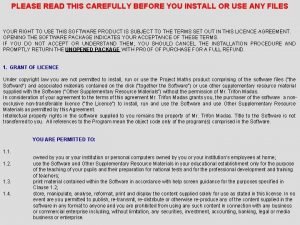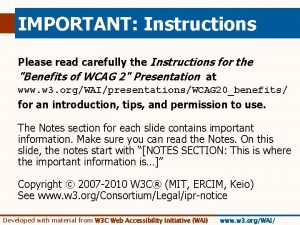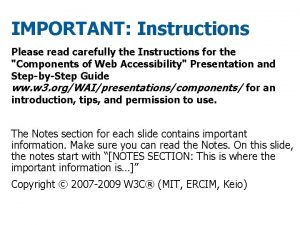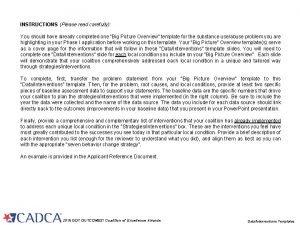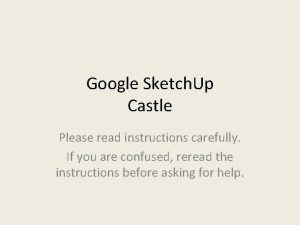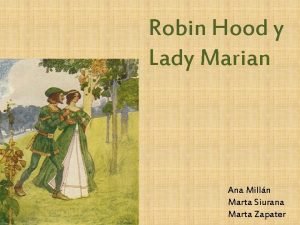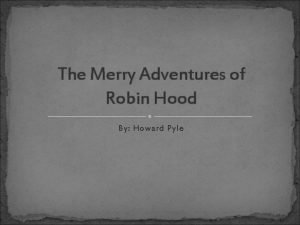Please read the following information and enjoy Merry

















- Slides: 17

• Please read the following information and enjoy. Merry Christmas and Happy New Year

British History: Part 8

1. In 1603 Hames VI of Scotland James I of England wanted to become King of Great Britain. 2. But Britain was torn apart by civil war in the years to come. 3. At end of this Britain was united, but is was a United Republic rather than a United Kingdom. 4. At the heart of the civil war were two opposing ideas – whether the King should govern as a God by his will or whether the people should be governed by their own consent. 5. This was a forerunner of the American and French revolution etc. 6. Out of this civil war came a genuine Parliamentary democracy

7. Charles I succeeded James I in 1625: • Believed kings were little Gods on earth • Saw himself as the father of the nation • Expected to be strictly obeyed 8. He listened to the people, but only when he chose and only about matters he thought were important. 9. But the many historians and lawyers in Parliament did not agree that Parliament should not be listened to. They thought back to Magna Carter. 10. These people saw themselves as the keepers of liberty – they wanted to protect liberty. 11. This was the starting point of the civil wars, but nobody realised it at the time.

12. The main trigger for the countdown to civil war was money 13. One of the first things that Charles I did was to declare war on Spain, and this was very expensive. He had to ask Parliament for money. 14. For Charles I this was a personal matter • Protestants and Catholics were killing each other all over Europe. • His own sister, the Queen of Bohemia had been forced into exile 15. Parliament gave the money for the war with Spain but they did not agree with the choice of commander, the Duke of Buckingham, who had been promoted above the great Earls of the land.

16. The Duke of Buckingham wasted 240, 000 pounds on a failed raid on France. 17. So Parliament said that if Charles I wanted any more money, the Duke of Buckingham would have to go. 18. Then in 1626 Charles dismissed Parliament and decided to raise the money on his own through a forced loan. 19. People who refused to loan the money were threatened and posecuted and two of them died. 20. Many people paid the loan because of fear. 21. Parliament said that no tax could be lawful without the consent of Parliament

22. Money ran out again in 1628 and Charles was forced to call another Parliament: • Speaker after speaker spoke in defense of the liberties of England. • They drew up a list of their complaints and Charles I agreed to it as long as The Duke of Buckingham could still be his commander. 23. Later in 1628 the Duke of Buckingham was assassinated. 24. Charles I shut Parliament down. 25. As Parliament was being closed, one MP, Elliot, said that anyone who imposed a tax without consulting Parliament would be an enemy of the state

26. Charles I put Elliot in the Tower of London, where he died in 1632. 27. In 1630 Charles I thought that peace had broken out in Britain as the war with Spain was over and he no longer had to beg for money. 28. But many in 1635 still thought that they should not pay Taxes without the agreement of Parliament. A Buckinghamshire landowner, John Handon. He had been upset by the treatment of Elliot, who had been put in prison. 29. Handon did not understand why counties with no coastline should pay ship tax.

30. The Puritans were not happy with Charles I: • The religion of Charles I still had a lot of signs and icons • And Charles I wanted to impose this on everyone else 31. The Puritans declared war on any signs of Romanism in the church. • They were against paintings, statues and crucifixes 32. It didn’t help that Charles I was married to a Catholic 33. Charles I made William Lord the Archbishop of Canterbury in 1633. • William Lords was in favour of colour, the form of the cross on the altar, ritual, sacrament and ceremony 34. Lord presented his way of worship as an order. 35. People who disobeyed him had his ears cut off. 36. By 1635 Charles I saw no obstacles to harmony across England, Ireland Scotland.

37. But Charles I’s obsession with union with Scotland led to hatred. 38. Charles I was born in Scotland was essentially Scottish but he was mostly absent from Scotland. 39. Charles I wanted to impose the same way of worship that he had imposed on England, but Scotland was different in its approach to religion than England. 40. On 23 rd July, 1637, there were loud protests in Endingburgh cathedral as the Bishop began reading from the new, Royally approved prayer book. 41. On 28 th February, 1638, thousands of Scots signed a covenant which became a statement of who was a true Christian and a true Scot.

42. Charles I considered them all to be rebels and that they should all be punished. 43. But the Scots had a large army. 44. Charles I found that he couldn’t raise money and he couldn’t raise men. 45. After the first round of violence, a truce was signed. 46. Charles I was desperate for money and men, so he called a Parliament in 1640. 47. But this new Parliament remembered their old complaints and Charles I closed it again 3 weeks later. 48. Charles I was not going to give in to teh Scotts and he was not going to reopen parliament.

49. His Lord Deputy in Ireland, Thomas Wentworth, had the idea of using an Irish Catholic army to defeat the Protestant Scottish army. 50. But Cahrles I knew that Protestant England was unlikely to approve of a Catholic army attacking their Protestant brothers in Scotland. 51. In 1640 there was a breakdown in order. English officers were being attacked by their own men. Newcastle was captured bythe Scots and to get it back Charles needed money so he reoppened Parliament.

52. John Pym, a main figure in Parliament, demanded: • No taxes unless Parliament approved • Parliaments to be elected every 3 years • No Parliament can be dissolved without its own consent 53. When Charles I agreed it was the destruction of the absolute monarchy. . . or was it? Charles I still had one card he could play – the Catholic army raised in Ireland by Thomas Wentworth. 54. Pym tried to convict Wentworth of treason, but this required the signature of Charles I. 55. Wentworth knew that only his own death could save the King and the country from further trouble.

56. Wentworth persuaded Charles I to sign his execution order and Wentworth was beheaded. 57. After Wentworth’s execution, Ireland’s Catholics felt unprotected against Englands protestants and they attacked in a pre-emtive strike: • Late in 1641 there was news of Catholics killing Protestants in England 58. Images of babies being killed in publication made English Protestants paranoid. 59. It was rumoured that the catholics were under order from Charles I 60. The Puritans feared that they would be next to be attacked.

61. Pym saw this as his moment to take away all the powers of Charles I. 62. Charles I tried to arrest Pym, but he escaped. 63. Charles now seemed to be a blundering dictator. 64. Pym made it clear that Parliament needed to protect itself and England from the Charles I. 65. Parliament raised an army. 66. Families were divided in the civil war that ensued. 67. The Battle of Edgehill was the first Battle of the civil war on 23 rd October, 1642. No decisive advantage was gained. 68. After Edgehill, local fighting broke out all over England. 69. Parliament held on to London

70. Charles I was based in the North and South West. 71. By the Autumn of 1643, Parliament was utterly demoralised: • Bristol had fallen to the Royalists • Charles I had established a Royal Court and a military government in Oxford 72. On September 25 th, 1643, there was an alliance between Parliament and the Scots. 73. In July 1644 on Marston Moor near York, The Anglo-Scottish alliance defeated Charles I’s army. 74. In the Winter of 1644/45, Oliver Cromwell created a new discplined army for Parliament. 75. In June, 1645, the New Model Army of Cromwell defeated the Royalists at teh battle of Naseby.

76. The Royalist strongholds were taken one by one. 77. The war was over and Parliament had won. 78. But Charles I did not want to accept that he was no longer the supreme power. He tried to make the army go againast Parliament. 79. Oliver Cromwell realised that Charles I had to go. 80. There was a second civil war. 81. Oliver Cromwell defeated the Royalists in 1648 at Preston and Charles I was finally defeated. 82. It was realised that Charles I would have to be executed if the country was to heal 82. On January 30 th 1649, Charles I was beheaded. 83. It was a turning poing in British history – the birth of a republic.
 What is the theme of the song heal the world
What is the theme of the song heal the world Will you please be quiet please summary
Will you please be quiet please summary Rejoice and be merry in songs and in mirth
Rejoice and be merry in songs and in mirth Please read the sentences carefully
Please read the sentences carefully Please read instructions carefully before use
Please read instructions carefully before use Please read
Please read Please read instructions carefully before use
Please read instructions carefully before use Please read this carefully
Please read this carefully Please read carefully the instructions
Please read carefully the instructions Please read carefully the instructions
Please read carefully the instructions Please read carefully the instructions
Please read carefully the instructions Please read our
Please read our Read aloud the following sentences
Read aloud the following sentences Please read instructions carefully before use
Please read instructions carefully before use Translate
Translate Robin hood (serie de televisión)
Robin hood (serie de televisión) Degrees of comparison for kind
Degrees of comparison for kind The merry adventures of robin hood characters
The merry adventures of robin hood characters




